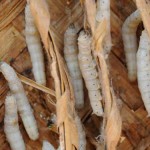
Volcanic eruptions release particles that reflect sunlight back into space. Image: Shutterstock.
Small particles released into the stratosphere could improve food security, but may have unseen consequences for Earth’s climate.
Global crop yields have already been affected by climate change in recent decades. A number of interesting strategies have been proposed to combat this and improve future, including sunshade geoengineering- reflecting sunlight away from the Earth.
This already happens naturally- volcanic eruptions release small particles into the stratosphere and cool the planet. But these particles fall out within 12 months and the planet warms up again, so scientists have turned to man-made solutions.
One proposal is to use airplanes to replenish a layer of small particles in the stratosphere, which would reflect sunlight back into space. It has been suggested that this method would threaten the global food supply, which is already projected to be impacted by increasing temperatures.
However, new research from the Carnegie Institution for Science, US, suggests that sunshade geoengineering is more likely to improve food production. “In many regions, future climate change is predicted to put crops under temperature stress, reducing yields,” lead researcher Julia Pongratz said. “This stress is alleviated by geoengineering.
“At the same time, the beneficial effects that a higher CO2 concentration has on plant productivity remain active.”
The study, published January 22 in Nature Climate Change, used two different models to simulate climates with carbon dioxide (CO2) levels to similar today, with levels if current trends continue and levels if sulphate aerosols deflect approximately two per cent of incoming sunlight.
They then applied these changes to crop models and found that sunshade geoengineering would lead to increased cop yields in most regions. This is because deflecting sunlight would reduce temperature, not CO2.
But even if geoengineering could improve crop yields, it doesn’t solve other problems created by the increased carbon dioxide emissions, such as ocean acidification. “The climate system is not well enough understood to exclude the risks of severe unanticipated climate changes, whether due to our fossil-fuel emissions or due to intentional intervention in the climate system,” Pongratz said.
“Reducing greenhouse gas emissions is therefore likely a safer option than geoengineering to avert risks to global food security.”
There are also other risks in using sunshade geoengineering. Some areas may be harmed by the methods and deployment of these systems could lead to political or military conflicts.
Source: Eureka Alert.






